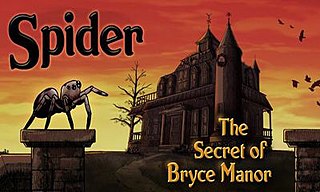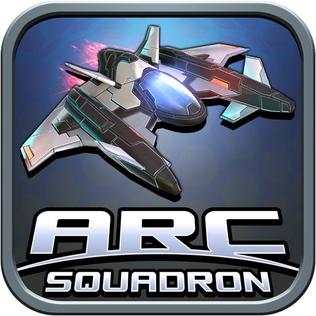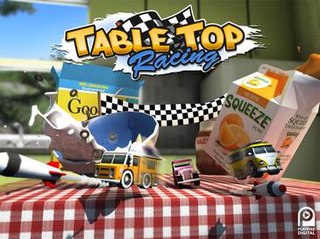
Death Rally is a vehicular combat racing video game developed by Remedy Entertainment, published by Apogee Software and distributed by GT Interactive. Originally known as HiSpeed during development, it was released on 7 September 1996 for MS-DOS. In the game, the player starts with $495 and a weak car named Vagabond, and must compete in deadly races where all cars are armed. The player wins money by finishing in front positions, collecting money bonuses during the race, fulfilling missions and destroying other cars. The ultimate goal of the game is defeating the "Adversary", the undisputed king of Death Rally, in a one-on-one race.

The Adventures of Tintin: The Secret of the Unicorn is an action-adventure, platforming video game based on the film The Adventures of Tintin: The Secret of the Unicorn, which is based on the series The Adventures of Tintin, the comics series by Belgian cartoonist Hergé. The game was released for Microsoft Windows, Nintendo 3DS, PlayStation 3, Wii and Xbox 360 on 21 October 2011 in Europe, on 1 December in Australia and on 6 December in North America. The game was developed by Ubisoft Montpellier, working in collaboration with the producers of the film, and published by Ubisoft. The iOS, Android and Symbian^3 versions were published by Gameloft and released on the App Store and Android Market on 31 October 2011, and on the Ovi Store on 11 January 2012. The online services for the game were shut down on 6 October 2015.

Hysteria Project is a 2009 FMV adventure game developed and published by French studio BulkyPix for iOS and first released on the App Store on April 7, 2009. It was released as a PlayStation mini available for play on the PlayStation 3 and PlayStation Portable on April 15, 2010 in Europe and April 22, 2010 in North America. The port was published by Sanuk Games. A sequel was released on the App Store in 2011, Hysteria Project 2.

Ultimate Spider-Man: Total Mayhem was a 2010 action video game for the iOS and Android systems. It was developed and published by Gameloft. The game takes place in the Ultimate Marvel Universe (Earth-1610). It is no longer available for purchase in the App Store for iPhone and Google Play Store for Android. The game features a rogues gallery of villains from the Ultimate Universe, and is played as a series of occurring events rather than an overarching plot. The title received generally favorable reviews from critics, with the iOS version holding an 85/100 on Metacritic.

Real Racing 2 and 2 HD for the iPad release, is a 2010 racing game, developed and published by Firemint for iOS, Android, OS X Lion and Windows Phone 8. It was released on December 16, 2010 for iPhone and iPod Touch, powered by Firemint's own Mint3D engine. A separate iPad version was released on March 11, 2011. On January 11, 2012 Real Racing 2 was confirmed as one of twenty-seven titles to be released on Windows Phone as part of a partnership between Electronic Arts and Nokia. The game is the sequel to 2009's Real Racing, and the download requires a one-time payment. It was a critical and commercial success, and a further freemium sequel, Real Racing 3, was released in 2013.

Tom Clancy's Rainbow Six: Shadow Vanguard is a 2011 first-person shooter video game developed and published by Gameloft for iOS, Xperia Play and Android devices. The game is a remake of the original Tom Clancy's Rainbow Six video game.

Asphalt 6: Adrenaline is a racing video game developed and published by Gameloft and is the sixth major game of Asphalt series. It was released for iOS on December 21, 2010, for Mac OS X on February 17, 2011, for Android on June 15, for Symbian^3 on July 20, for Mobile phones on August 31, for webOS on September 3, for BlackBerry PlayBook on October 12, and for Bada 2.0 on January 10, 2012.

Annoying Orange: Carnage is a 2011 casual mobile game developed by Bottle Rocket and published by Eastedge Studios. Based on the comedy web series Annoying Orange, players throw various produce items into blenders across a kitchen, earning them points for each successful throw. A total score will be calculated when a time limit has been reached.

Dead Space (also referred to as Dead Space: Sabotage or Dead Space (mobile)) is a 2011 survival horror mobile game developed by Australian company IronMonkey Studios and published by Electronic Arts for iOS and Android-compatible devices. A spin-off within the Dead Space series, the game is set after the events of original Dead Space and prior to the events of Dead Space 2 and shows how the Necromorph outbreak began and spread through the Titan Sprawl. Gameplay features protagonist Vandal navigating through chapter-based environments, fighting Necromorphs.

Jetpack Joyride is a 2011 side-scrolling endless runner action video game created by Halfbrick Studios. It was released for iOS devices on the App Store on September 1, 2011 and has been ported to other systems. It was released online as a Flash version on May 11, 2012; on Android on September 28; on PlayStation Portable on November 20 in North America and November 21 in Europe; on BlackBerry PlayBook on December 13, 2012; on PlayStation 3 and PlayStation Vita on December 21 in Europe and December 31 in North America; on BlackBerry 10 on March 6, 2013; and on Windows Phone 8 and Windows 8 on June 5. It was also released on PlayStation 4 on April 26, 2016. A mobile version using the keypad was released in 2021 for KaiOS devices.

Spider: The Secret of Bryce Manor is a 2009 side-scrolling action-puzzle video game for iOS and Android, developed and published by Tiger Style. The player takes control of a spider who comes to reside in to the deserted Bryce Manor and must spin webs to trap various types of insects, whilst simultaneously ascertaining what happened to the former residents of the manor. The game received critical acclaim and won multiple awards. Originally released in August, a Director's Cut update replaced the original version on the App Store in December. The update added ten levels, twenty-four Game Center achievements, new music, more story elements and an insect. A year after the game's initial release, a HD version was released for the iPad. In 2013, the game was also released for Android. A sequel, Spider: Rite of the Shrouded Moon, was released in August 2015 for iOS, Android, Windows, Mac and Linux.

Wild Blood is an action game developed and published by Gameloft for iOS and Android in 2012.

Shadowgun is a 2011 third-person shooter video game developed and published by Madfinger Games for iOS, BlackBerry PlayBook and Android. The game was followed by successful sequels Shadowgun: DeadZone (2012) and Shadowgun Legends (2018). The company is also preparing Shadowgun War Games focused on team based PvP gameplay and esports. In 2013, the game was ported to Ouya and BlackBerry 10, and was also released as a pre-installed app on PlayJam's GameStick for anyone who supported the GameStick Kickstarter campaign.

ARC Squadron is a 2012 space combat video game developed and published by Psyonix Studios for iOS. It was released on the App Store on 1 November 2012. Like Psyonix's previous game, Supersonic Acrobatic Rocket-Powered Battle-Cars, ARC Squadron runs on Unreal Engine 3. On 17 October 2013, ARC Squadron: Redux was released on iOS and Android, featuring improved graphics and performance as well as gameplay tweaks.

Temple Run 2 is an endless runner video game developed and published by Imangi Studios. A sequel to Temple Run, the game was produced, designed and programmed by husband and wife team Keith Shepherd and Natalia Luckyanova, with art by Kiril Tchangov. It was released on the App Store on January 16, 2013, on Google Play on January 24, and on Windows Phone 8 on December 20. In November 2020 Imangi Studios released Temple Run 2 for the web on Poki.

Real Racing 3 is a 2013 racing game developed by Firemonkeys Studios and published by Electronic Arts for iOS, Android, Nvidia Shield and BlackBerry 10 devices. It was released on iOS and Android on February 28, 2013, under the freemium business model; it was free to download, with enhancements available through in-app purchases. It was considered that it had one of the best graphical experience at that time. Over time and despite an expensive virtual economy ingame, the developers began to tolerate the use of playing with time zones in order for the players to watch unlimited ads to get free gold.

Table Top Racing is racing video game developed and published by British studio Playrise Digital. The game was originally developed for iOS on January 31, 2013, and later released for Android devices on January 23, 2014. A PlayStation Vita version was released on August 5, 2014.

Pix'n Love Rush is a platform game released for iOS, PlayStation Portable, and Ouya in 2010-2013. An updated version called Pix'n Love Rush DX was released only for iOS on December 16, 2010.

Cordy is an iOS and Android game developed by SilverTree Media/SilverTree Holdings LP and released on July 27, 2011. Cordy is a platform game with 27 levels.

Blue Defense! is an iOS game by Canadian developer John Kooistra and released on Jan 31, 2009. A sequel entitled Blue Defense: Second Wave! was developed by Cat in a Box Games and released on September 30, 2010. Blue Attack! is a spin-off.



















